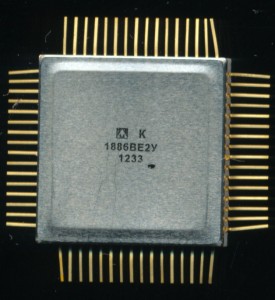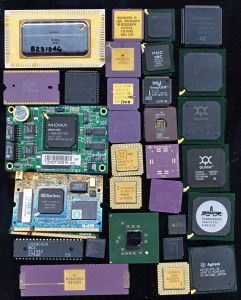March 24th, 2016 ~ by admin
I finally got more of the Intel MCS-4/40 Test Boards ready to ship. Grab yours soon if you want one. All other test boards are in stock too, including the RCA COSMAC boards, the Intel MCS-8 board and the Intel MCS-80 board (with Z80 8085 and NSC800 Expansions.
New Test Boards: Coming soon will be two new test board types. First is a board for the SC/MP and SC/MP II CPUs made by National Semiconductor. The second is a whole test system, designed to test Motorola 680x processors as well as MOS 650x processors and many of their derivatives. All told it’ll test over 30 different chip types! Even some of the more unusual/special versions. Commodore 6510? Yup! Nintendo Ricoh? Yup! and a whole lot more…
Coming Soon!
March 13th, 2016 ~ by admin
In Part 1 of our three part series on IC collecting we discussed why to collect vintage computer chips. For Part 2 we covered what to collect, how to set and keep a focus in your collection. For the final Part we’ll cover some of the ways of how to find and collect the IC’s you want.
Part 1: Why Collect Vintage Chips?
Part 2: What Vintage Chips should I Collect?
Part 3: How do I collect Vintage IC’s?
There are two main parts of the How of IC collecting. Where to I get my chips? and Where do I put them? For most collectors cost is a concern, for the right money you can have most any chip, but since i have yet to find the dollar/Euro/yen tree cost is a factor in acquiring chips. One of the greatest sources of chips is eBay. Several categories in particular are a good source of chips, IC?Processors in the Business/Industrial category, the CPU/Processors and Vintage categories in Computing, and Scrap/Recovered Gold. Of these Scrap Gold can yield some of the most interesting chips. Scrap sellers in general though have no idea about what they are selling (as far as collectibility) but most are happy to work with you. If you win a lot with a nice chip in it, send the seller a note to pack the chips well, and in most cases they will. They are sold as scrap though so keep that in mind if they don’t come in perfect shape. This can be a good chance to learn the art of pin straightening.
Read More »
March 10th, 2016 ~ by admin

Milandr K1886VE2U PIC17C756A w/ Flash Memory
We have previously talked about the Microchip PIC17, and its less then stellar success in the market. After being introduced in the early 1990’s it was discontinued in the early 2000’s, though Microchip continued to provide support (and some devices) to users for some time after that.
In the early 1990’s a IC company was formed in Zelenograd, Russia (just a short distance to the NW of Moscow), the silicon valley of Russia, home to the Angstrem, and Micron IC design houses. This company was Milandr, one of the first post-Soviet IC companies, with ambitious plans, and many highly capable engineers from the Soviet times. They are a fabless company, though with their own packaging/test facilities, specializing in high reliability metal/ceramic packages.
The K1886VE is Milandr’s version of a PIC17C756A, though updated for the 21st century. While mask-ROM versions are available the VE2 version replaces the ROM with modern FLASH memory. This is a upgrade that perhaps would have kept the PIC17 alive if Microchip would have done similar. It is packaged in a 64 pins CQFP white ceramic package with a metal lid and gold leads, not what one is use to seeing a PIC in. Production of these PICs continues at Milandr (the pictured example is from 2012), as customers still use the parts, mainly in industrial and other places where reliability is key.
The use of a PIC in high reliability applications isn’t something entirely new. The Microhard MHX-2400 radio system, designed for small satellites such as cubesats, runs on a PIC17C756A, a version flew on NASA’s Genesat-1 in 2006 carrying bacteria samples. Milandr does offer radiation resistant devices so its likely that some Milandr PIC has flown to space as well.
March 1st, 2016 ~ by admin

Where do I start? Where do I end? Focus!
In Part 1 of our three part series on IC collecting we discussed why to collect vintage computer chips. For Part 2 we’ll cover what to collect. which is the most important part of collecting (not just IC’s but anything).
Part 1: Why Collect Vintage Chips?
Part 2: What Vintage Chips should I Collect?
Part 3: How do I collect Vintage IC’s?
There are millions of different IC’s made since the dawn of the IC in the 1950’s, obviously it would not be prudent to try to attempt to collect all of them, so one needs to set a focus for their collection. The earlier this is done, the easier collecting will be, and the less chance of going insane, broke, or both. The CPU Shack, as the name implies, began collecting just CPU’s, the brains of computers. Through the years (and due to things being donated to the museum) this has expanded to microcontrollers, SoCs. UV-EPROMs. GPU’s, and even the occasional DSP. It’s a broader slice of IC’s then most would want to attemp, at least when starting. So let’s figure out ways to gain a focus in collecting.
Read More »



